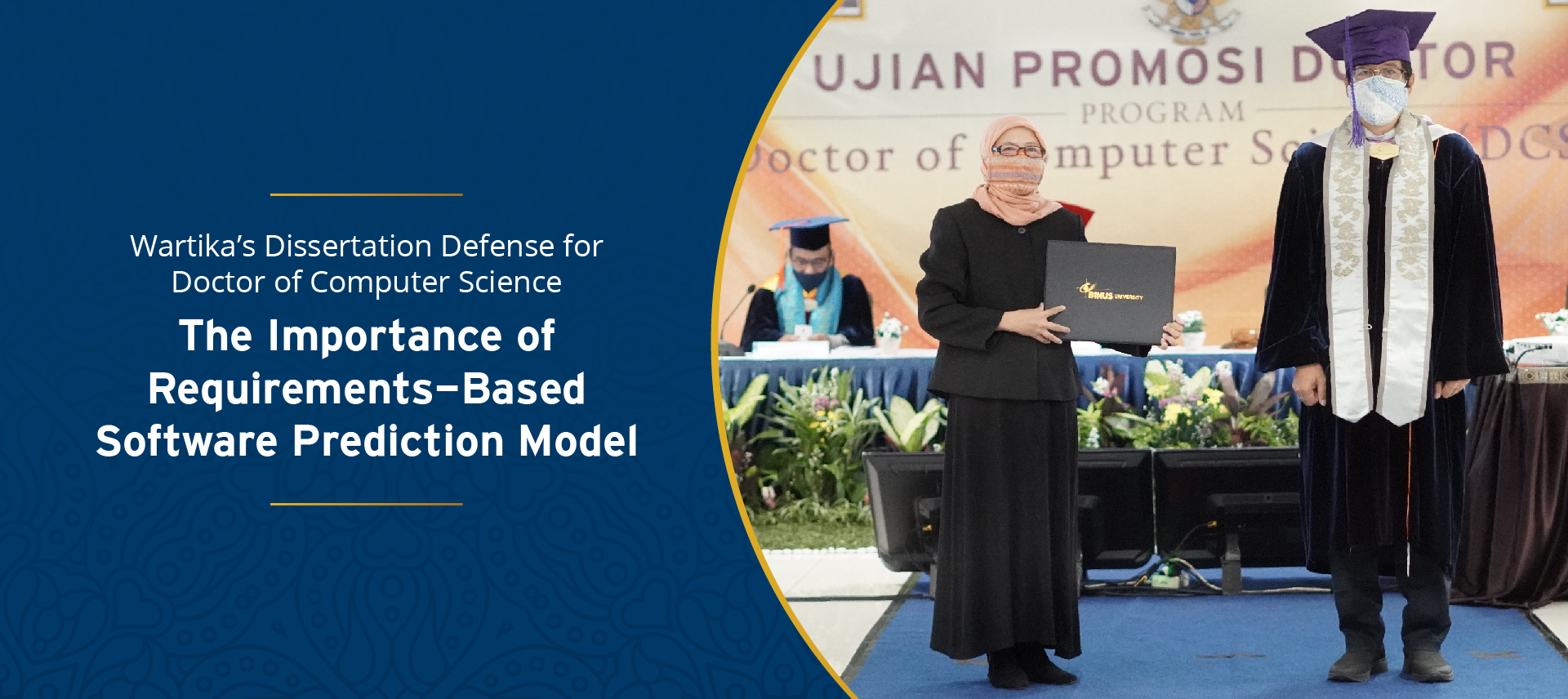The Importance of Requirements-Based Software Prediction Model

Quality, customer satisfaction, and reliable software products are highly important, especially in this all-around digital world. The quality of software depends not only on the design and coding, but also on the delivery time, budget, and its scope of functionality. Based on a study from Standish Group in 2009, only 32% of software projects that managed to deliver in time, on budget, and fully functioned.
From this problem, a prediction model is needed to make sure that all the efforts (money, time, and energy) are met and can be planned of time. The prediction model can also be used to increase accuracy and practicality in terms of software development.
On Thursday (17/9), BINUS University held a dissertation defense for Wartika Memed Purawinata, a student in the Doctor of Computer Science study program. Joining Wartika, the promoter team consisted of Prof. Dr. Widodo Budiharto, S.Si., M.Kom., Dr. Ford Lumban Gaol, S.Si., M.Kom., and Ariadi Nugroho, M.Sc., Ph.D.
Wartika Memed Purawinata, esteemed lecturer and software developer
Wartika started her academic journey by studying at Institut Pertanian Bogor (IPB University) for her bachelor’s degree in 1989. By 1997, she had completed her bachelor study at STMIK Bandung, taking the Information Systems degree.
In 2014, Wartika completed her Master of Information Technology degree at Institut Teknologi Bandung (ITB) and started to pursue her Doctoral degree in Computer Science at BINUS University in 2016. Apart from her extensive degrees, Wartika is an esteemed lecturer at Universitas Komputer Indonesia (UNIKOM Bandung), specifically in its Information System study program. Her dedication as an educator also leads her to the professional software development projects, for both private and government institutions.
Wartika has also written many research papers that are published in national and international conferences. Her vast knowledge and experience in the software and computer industries have contributed massively to the academic world.
Requirements based software model to predict the complexity and effort estimation
Wartika presented her dissertation titled “The Prediction of Software Complexity Based on Complexity Requirements Using Effort Estimation” on Thursday, September 17th, 2020. She defended her dissertation in front of the examination committee led by Prof. Dr. Ir. Harjanto Prabowo, M.M. as the Rector of BINUS University, along with the promoter team.
Complexity directly affects the required time and fund for software development. Therefore, identifying the software’s complexity should be done at the very start of the process, before jumping into the design and coding process. Although it is important to note that efficient software development requires an accurate prediction.
With these in mind, Wartika’s dissertation aims to create a software complexity prediction model with a requirements basis that can be used to estimate the effort. The dissertation also aims to analyze the performance and accuracy of the prediction model. Wartika has compiled three previous studies and added more measurement parameters to increase accuracy. During the research and model construction, Wartika used regression analysis techniques and non-linear statistical data modeling tools, which was an artificial neural network.
Based on the normality test and statistical analysis, Wartika managed to construct 5 levels of software complexity, from the lowest to highest, Not Complex, Quite Complex, Complex, Very Complex, and Highly Complex. Wartika also found that requirements (requirements document factor, cost driver factor, and function point) are viable variables to predict the software complexity, each simultaneously has a 79,9% effect on the software complexity, whereas the other 20,1% is affected by outside variables. From the constructed model, Wartika proved that it affects 48,9% of the effort estimation.
By using mean squared error, Wartika concluded that the model performance triumphs by 5.1e-01 when compared to the previous research done by Arthi. The accuracy is also 19,4% than the previous model from Arthi, which in total is 72,2% guaranteed accuracy. ** (PID)

